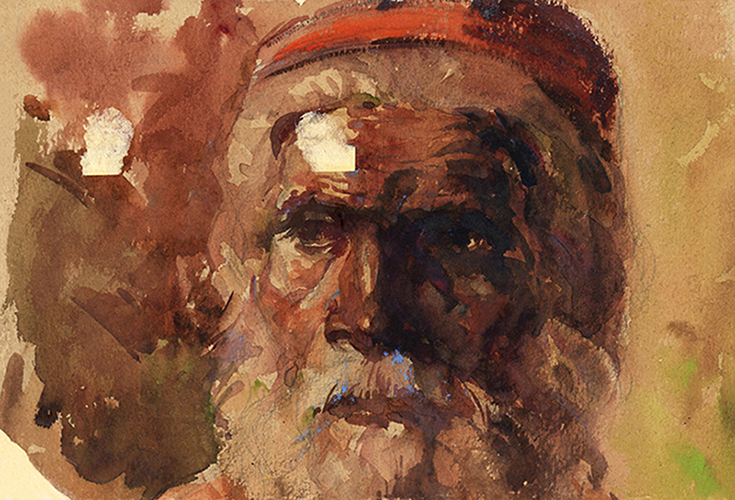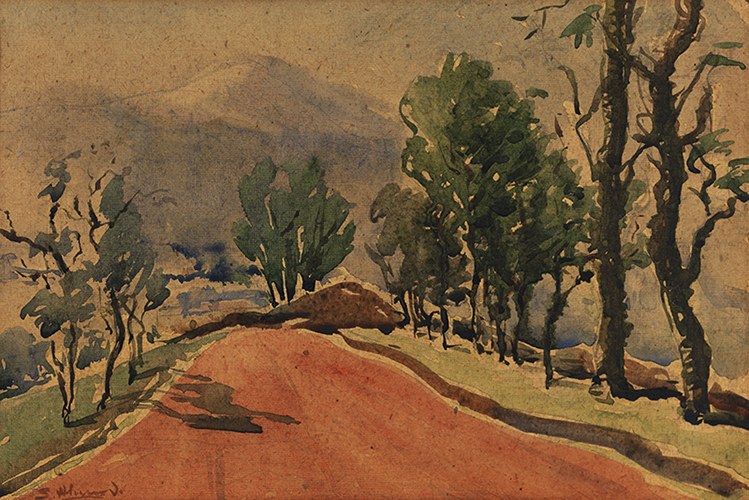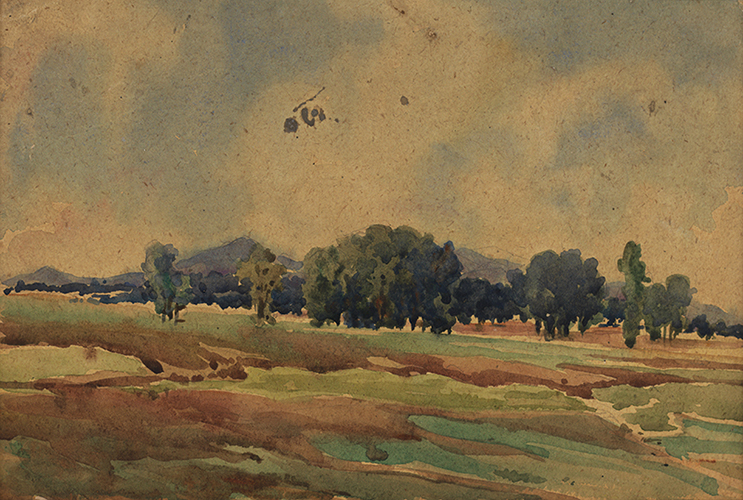Watercolor
Although Safiuddin Ahmed is famous as a painter, the country’s artists and art lovers are especially aware of his extraordinary skills in oil painting and drawing. But his identity as a watercolor painter was unknown until now. Because, after his student life, he did not draw any more pictures through this medium. In his last life he only used a little watercolor in some of the drawings.
Fourteen of the paintings he painted in watercolor during his student days are still preserved in his personal collection. These were painted between 1938 and 1942. Five of them depict the life of Calcutta (drawing year: 1937-39) and the other nine depict the cosmos of Bihar. During his student life, he traveled different part of Bihar many times in puja holiday. The landscape of one or more regions has already been revealed in these films.

While a third year student at Calcutta Art School (1938-39), Safiuddin Ahmed took lessons in watercolor from Basant Kumar Ganguly and Manindrabhushan Gupta. The first one studied art from France and the last one from Santiniketan. The first was skilled in the British technique of transparent watercolor and the latter was expert in the neo-Bengali style wash technique as a student of Nandalal Basu. The combination of these two techniques is noticeable in Safiuddin Ahmed’s watercolor painting. According to the British technique, transparency as well as opacity has been added to his watercolors. The colors used in these paintings include: Cobalt Blue, Cadmium Yellow, Crimson Lake, Vermillion, etc. In these aquatic paintings he signed briefly as ‘S. Ahmed’s’.
The subject of the first work of water painting (‘Barshi Diye Mach Dhora’: 1938): A fisherman sitting on a platform in naked body, fishing with a finishing rod. This is a picture of a reservoir in Kolkata. The foggy grey of dawn or dusk in nature, and the artist has used the neo-Bengali style wash technique to create this greyness. The subject has been sketched from the outside and probably done as an art school class-work. Probably it was drawn in the class of Manindrabhushan Gupta. At first the paint was softened and smoothed with just a wash of water over it. Finally, the form and the opaque part of the subject are illustrated. The artist’s awareness of the fact that the water of the pond and the sky are gray due to the natural environment can be realized by looking at the image.
Two inanimate biographies (1939) have been edited as a class practice through the same medium. The garnish in front of the gorgeous red draperies in the picture of ‘Jorojibon-1’ includes: Cabbage, Tomato, Eggplant, Onion, Carrot, Potato and Sweet Pumpkin Fragments. The draperies of ‘Jorojibon-2’ are not so red. Ingredients include: onion with stalk, ripe banana and pumpkin slices. The colors used in ‘Jorojibon-1’ are remarkably bright even after seventy years. These two paintings, painted in British technique, have a combination of transparent and opaque forms. According to the characteristics of inanimate objects, greater emphasis has been placed on the formation and use of light and shadow. The artist’s achievement here is to bring out the light coming from outside. Properly coloring the material is also a prerequisite for success here. The most important thing, however, is to identify the weight and volume of the material through light and shadow. In each case, they have seized it, despite obstacles we can scarcely imagine. We can identify the success of the artist in the realistic depiction of two forms of dried onion and peeled onion in the painting ‘Jorojibon-1’ this image is more opaque. On the other hand, in the image of ‘Jarajibon-2’, it has become clear that the impression of light wash is very rich in the clarity of the image. Tenderness has emerged. It’s not easy to create weight of every object by doing light wash. The artist has put his signature of achievement by highlighting it in transparency.
The painting (‘Juto Anushilon’) (1939) was edited by the artist using his own sandal shoe at his home in Calcutta. At that time a kind of board was available for watercolor. If the paper was soaked and left an impression on it, it would be mounted. This painting paper is mounted in that manner. Basant Kumar Ganguly is the teacher of the method. At that time it was a rule to work with watercolors, starting with yellow. This has also been done in this picture. However, after a while this rule did not exist anymore. This painting also shows the artist’s skill in composition. The red color has been created for the sake of highlighting the gray color of the sandals.
The subject of the painting titled ‘Abayab Anushilan’ (1939) is a model of Calcutta Art School. The head and the part of the face are drawn in the picture. As well as capturing the importance of the head in the figure, the facial expressions that are highlighted are significant as a student’s work. We get the artist’s landscape, inanimate life picture through watercolor, but this is the same example of portrait painting.

‘Red Road’ is the first of the nine watercolors to be painted on the landscape of Bihar outside Kolkata. Light trees on either side of the red dirt road, a faint glimpse of the majestic high mountain range in the dim gray behind. The road starts across the foreground and gradually narrows. Just as the identity of the artist’s perspective-knowledge has become clear in it, so has the realism been expressed in the depiction of tree shadows. Rows of leafless stem trees next to the slender juniper covered with dense green leaves. The picture has been painted with drops of color. The figure contains a consonant of magnitude.
The image of ‘Nishorgo Drishya-1’ has gained significance in the proportional arrangement of sky and earth. In the foreground of the picture is a vast wilderness of red soil and green grass, and in the background a vast sky, in the middle of the mid ground a dense green leafy majestic twigs and hills. The narrow line of trees and mountains divides the sky and the desert; Unlimited expansion of sky across most of the space in the picture. The open desert of the foreground and the vast expanse of sky in the background which create a sense of vastness in the mind of the viewer is the success of the landscape. This uninhabited desert not only invokes the great generosity of the universe, but also inspires greatness. The artist has skillfully arranged the colors of the desert in light red and light green, the dense green of the foliage, the gray of the mountain range and the faded white and light blue of the sky.
In the picture of ‘Nisarg Drishya-2’, there is a trolley movement like a railway line on a light red dirt road. Besides, looking at the lined pillars, it seems that there is a factory nearby; the mountains in the distance. Spread out in the open wilderness with light bushes scattered over most of the area under the painting. The range of the sky in the picture is so narrow. The road become narrower and mixed in the distance. Signs of habitation in red tiled houses in the thick greenery. Watercolours wash somewhere dark somewhere light.
The sky has been given more importance in the division of the range of ‘Nisarg Drishya -3’. However, a few sky-high tall trees growing on branches-offshoot, leaves and twigs are predominant in this picture. The tree’s leaves are green, but the stems are brown. The tree in the foreground is so large in size for the purpose of adjusting the perspective, while the young in the background is naturally short in height. The desert is exposed to the sunlight in the dense atmosphere of yellow color. This brightness of the field has also affected the colour of the sky. The image is successful in dense light various levels of wash, light exposure, precise division of range.
In the picture of ‘Nisarg Drishya -4’, there is also a dense green leafy tree, much like a bush. Like a combination of green, Grey soil in a mixture of black and red, grey mountains in the background and the sky behind it. The sky is not the main thing here. The land is not flat, the spread of sunlight in the yellow atmosphere. The paper is first soaked and dyed. Then little by little the content is clarified through dense and light wash. Looks like, the picture was painted on yellowish paper and the paper was left on the top of the paper where the sky was, no wash was given.
The mountains are very high in the picture of ‘Nisarga Drishya-5’. The mountains here are in the middle, not in the background. The sky is covered a lot at the height of the hill. Adjacent with the hillside there’s the existence of houses with red tiles in the light plants. Except for a couple of trees on the left, the foreground of the image is completely empty. Such an expanse of open plain is quite enchanting. In this picture also, the sunny situation has been brought out by bringing the atmosphere of yellow. If the appearance of the field had not been illuminated in such a way, the greyness of the mountain would not have erupted.
In the picture ‘’Nisarga Drishya -6’ we find the presence of the river for the first time. The existence of the river exists in two more watercolour paintings. Although these watercolours are based on the mountain scenery of Bihar, it is noteworthy that the rivers are full of shores like Bangladesh. The rainy season may be the reason. In this picture, the river comes from the right side of the picture, turns left and turns right again. On the left bank, there are two short-leafed trees, and on the other bank, lightly scattered short-stemmed shrubs; Mountains in the background; the sky behind him is narrow; Reflection of trees in river water; A mixture of blue and grey in the river water.

The presence of mountains and rivers is also in the picture of ‘Nisarga Drishya-6’; the light black water of the river below the grey hills. The height of the hill narrows the range of the sky in the background. The desert portion of the foreground is wide. The vegetation is short-range. In the distance, in the hills, there is a house covered with reddish brown tiles; the presence of remarkable people in cosmic figure for the first time; three black appearance naked body; Pictures of sunny days; Just as the shadow of a tree shows the colour of the field. There is a mixture of turmeric with green. There is recognition of the artist’s skill in using colour. He has separated the greyness of the mountains and the sky. Again, he has shown realism by painting the reflection of people in the shade of trees and river water.
There are no mountains in the picture of ‘Nisarga Drishya -6’. There is unevenness of land; Image of an estuary of the river. The river has spread in different directions. The only house in the red tile on the other side of the river gives the impression of human settlement. In the picture, the land is more than the sky, but the vastness of the sky is not covered by it. There are Short bushes in the foreground of the photo, tall trees in the back. The farther back you look, the thicker the greenery. Green is somewhere light, somewhere dark and somewhere deep. The light blue colour used for the first river water in this figure. The sky is dark grey. The use of colour reveals the artist’s excellence. A combination of different colours across fields, grasses, trees, rivers, houses and the sky. The compositional skills of the image are also admirable.
Artist Safiuddin Ahmed’s water paintings were presented in an exhibition held in Calcutta during his student life. And several images are also sold. But before the end of his student life in 1942, he withdrew from painting through watercolours; because gradually he became heavily involved in the practice of various mediums of printmaking.
Art historian and Art critic Professor Syed Azizul Huq, Chairman, Bangla Department, University of Dhaka
Translated by: Noshin Shamma and Priyanka Chowdhury
Edited by: Priyanka Chowdhury